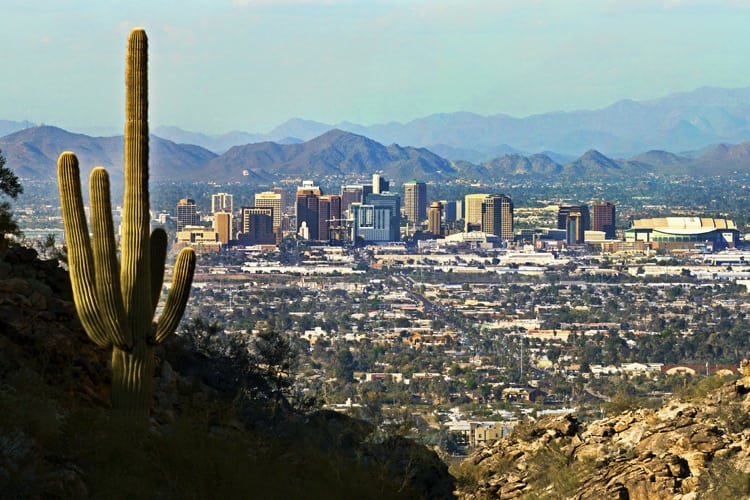With continued low unemployment rates, sustained population growth and surges in key industries, Arizona’s economy continues its positive trajectory. These were the findings presented last week by prominent economist Dr. Christopher Thornberg of Beacon Economics at the Alliance Bank of Arizona 2019 Economic Forum.
Steady growth was seen across all areas of Arizona, as every major metropolitan area in the state experienced solid job growth and consistently low unemployment rates. Looking from the second quarter of 2017 to the second quarter in 2018, Arizona’s economy grew 6.8 percent compared to 5.4 percent nationwide. Employment increased by 93,900 workers, a 3.3 percent increase from Dec. 2017 to Dec. 2018, while population growth was at 2.2 percent, which was significantly higher than the 0.4 percent experienced nationwide. Similarly, during the same period, the state’s unemployment rate sits at 4.8 percent, which is higher than the 3.9 percent national rate.
In terms of job creation, 11 major job sectors across the state recorded job gains year-over-year. Specifically, the top four industries leading job growth included:
• Construction added 19,200 new jobs at a 12.7 percent rate of growth.
• Information added 4,600 new jobs at a 10.2 percent rate of growth.
• Professional and Business Services added 18,100 new jobs at a 4.2 percent rate of growth.
• Leisure and Hospitality added 10,800 new jobs at a 3.3 percent rate of growth.
As well, largely due to the state’s continued population growth, the housing market continues to advance, with increases in the median home price and a rise in construction permits. With these economic indicators, Dr. Thornberg projected that Arizona’s economy will continue to grow and add jobs over the next year, with nearly every industry expected to contribute to overall growth.
Other notable findings:
• Tourism: The influx of new jobs in the tourism sector helped the industry maintain momentum as it grew 3.3 percent. In addition to a 9.9 percent increase in lodging taxes collected through the first 10 months of 2018, the state benefitted from a 0.9 percent increase in national park attendance and a 6.1 percent increase in state park attendance.
• Consumer Spending: The increase in jobs and wages has translated into increased demand for goods and services. In Phoenix, year-to-date retail sales reached $1 billion, which was up 2.5 percent over the same period in the previous year. Additionally, restaurant and bar spending was up 6.9 percent ($428.8 million) during the same period.
• Residential Real Estate: The robust labor market contributed to a much-improved residential real estate market. While not quite at the pre-Subprime Mortgage Crisis levels, metro Phoenix recorded the most significant market impact with a median home price of $258,300, an increase of 7.3 percent from Sept. 2017 to Sept. 2018. Tucson experienced an 8.3 percent gain in housing prices year-over-year, which is a full percentage point higher than Phoenix. However, Tucson has only seen an increase of 29.5 percent over the past five years compared to 42.3 percent growth in Phoenix. Additionally, the increase in home values (and rental rates, which have increased by 7.2 percent in Phoenix and 4.5 percent in Tucson) has driven developers to build both single- and multi-family housing units. Single-family building permits issued increased by 12.3 percent statewide during the first 10 months of 2018 compared to the same period a year earlier, while multi-family permits grew by 5.2 percent.
• Commercial Real Estate: As local industries continued to grow, commercial real estate in Phoenix has followed pace. The average monthly office rent increased by 2.5 percent to $25.85 per square foot while office vacancy rates remained stable at 22.4 percent. The average monthly retail rent followed suit, increasing by 2.6 percent to $20.64 per square foot as vacancy declined slightly from 10.1 percent to 9.8 percent. Positive economic growth has also stimulated commercial construction growth in Phoenix, which saw 3.3 million square feet of office space – 73 percent of it speculative – under construction, which is a clear sign of optimism among commercial developers.
Economic growth among key regions in the state:
• Metropolitan Phoenix: Employment continues to increase as a growing population (1.7 percent increase from 2017 and 8.9 percent increase from five years ago) adds to the supply of available workers. The area supported 2.2 million jobs that represented a 3.7 percent increase from a year earlier. Despite the increase in employment, the unemployment rate increased to 4.4 percent from 3.9 percent a year earlier. Moreover, all major sectors in Maricopa County increased wages: Leisure and Hospitality by 5.8 percent; Financial Activities by 4.9 percent; Other Services by 4.8 percent; and Construction by 4.8 percent. The robust economy, combined with the area’s ability to attract high levels of domestic migration increased the price for both residential and commercial real estate. Greater Phoenix’s economy will continue to add jobs over the next year with the construction industry leading the way thanks to a booming housing market.
• Tucson: Arizona’s second-largest metro area continues to grow, with employment increasing by 2.5 percent from Dec. 2017 to Dec. 2018. While the unemployment rate only grew slightly (4.2 percent to 4.8 percent), 16,000 newcomers entered the labor force. Manufacturing saw the most employment growth (6.5 percent), with Construction (6.1 percent), and Information (5.7 percent) making up the top three industries. Financial Services experienced a slight decline (-0.6 percent), while Other Services and Natural Resources and Mining saw no growth. Average wages in the Tucson MSA economy increased by 4.3 percent from second quarter of 2017 to the second quarter of 2018. Natural Resources and Mining increased by 9.8 percent, while Information (9.5 percent) and Manufacturing (5.0 percent) also grew. Growth, albeit slower, could also be seen in Education and Health Services (2.2 percent), Financial Activities (3.0 percent) and Leisure and Hospitality (3.2 percent).
• Flagstaff: Northern Arizona’s economy has been booming over the past year. While employment increased by 2.5 percent, due to a sizable increase in labor supply (up 2.9 percent year-over-year), the unemployment rate increased from 5.5 percent to 6.4 percent. Natural Resources and Construction led the way with an 8.3 percent increase year-over-year, followed by Leisure and Hospitality at 7.8 percent, while declines were seen in Trade, Transportation and Utilities (-3.1 percent) and Professional and Business Services (-3.1 percent). Wage increases, led by Natural Resources and Mining (16.3 percent), Construction (6.3 percent) and Other Services (5.4 percent) were also seen, with exception of Financial Services, which saw a decline of 1.5 percent.
Complete information including data sources can be found in the Regional Intelligence Report, prepared by Beacon Economics LLC and presented by Alliance Bank of Arizona.
To download the full version of the Regional Intelligence Report, click here.




